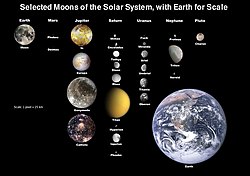Selenology
Selenology is the science of the Moon.[1][2] It is a branch of astronomy.[1][2]
Selenology Media
The far side of the Moon, lacking the near side's characteristic large dark areas of maria, resembling how the near side of the Moon might have looked early in the Moon's history
Artist's depiction of the Moon as it might have appeared in Earth's sky after the Late Heavy Bombardment around 4 billion years ago, when its orbit was half as close to Earth and it appeared 2.8 times larger than today.
Size comparison of the main moons of the Solar System with Earth to scale. Nineteen moons are large enough to be round, several having subsurface oceans and one, Titan, having a considerable atmosphere.
Moon's internal structure: solid inner core (iron-metallic), molten outer core, hardened mantle and crust. The crust on the Moon's near side permanently facing Earth is thinner, featuring larger areas flooded by material of the once molten mantle forming today's lunar mare.
An astronaut jumping on the Moon, illustrating that the gravitational pull of the Moon is approximately 1/6 of Earth's.
The thin lunar atmosphere is visible on the Moon's surface at sunrise and sunset with the Lunar Horizon Glow and lunar twilight rays, like Earth's crepuscular rays. This Apollo 17 sketch depicts the glow and rays among the general zodiacal light.
Gene Cernan with lunar dust stuck on his suit. Lunar dust is highly abrasive and can cause damage to human lungs, nervous, and cardiovascular systems.
References
- ↑ 1.0 1.1 A Dictionary of Physics (Fifth ed.). Oxford University Press. 2005. p. 474. ISBN 9780192806284.
- ↑ 2.0 2.1 "selenology". TheFreeDictionary.com. Farlex. Retrieved 2011-09-05.








